Top News
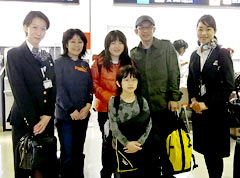
November 9, 2011 Ryukyu Shimpo
On November 8, 13 year-old Miyu Kaname, a 2nd grade student of Kamimori Junior High School in Urasoe, arrived at Narita Airport with her family after having been away from Japan for seven months. Diagnosed with restrictive cardiomyopathy, she underwent a heart transplant operation in the United States. Miyu looked rather tired after the long flight, but walked with steady steps, saying, “I am happy that I can run again.” She travels with her family to Osaka for a medical examination in Osaka University Hospital before going back to Okinawa on November 15.
“It hasn’t really sunk in yet, but I would like to express my gratitude and appreciation for all the support I have received,” said Miyu with a bashful smile. She said “I want to meet my friends who spent time with me in the hospital in Okinawa and I also want to go back to school soon.”
Before the operation, aspects of her daily life were very restricted, for example, her lips turned blue just after running a just a little, “Now I can run without struggling the way I used to,” she said, mentioning that she wants to start playing tennis again. She has also tried yoga as a part of her rehabilitation program during her stay in the United States.
She has resumed a normal diet except for raw food such as sashimi, and some fruits. Her father Toshiaki Kaname was concerned that the dietary limitations may stunt her growth, but she has grown three centimeters in height since the operation. The people who welcomed her back at the airport were pleased to see that she is growing well.
Her father said, “I am relieved to be back in Japan, and now I would like the people of Okinawa to see my daughter’s happy face.”
(English Translation by T&CT, Shinako Oyakawa and Mark Ealey)
Go To Japanese
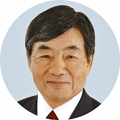
November 8, 2011 Ryukyu Shimpo
At a routine press conference held on November 7, with regard to making a direct request to the United States Government to relocate the Marine Corps Futenma Air Station outside of the prefecture, Nago Mayor Susumu Inamine said, “If I cannot visit the United States as a member of the Guntenkyo Council (Okinawa Municipal Council for Military Land Conversion and Base Problems) I will go in my capacity as the mayor of Nago.” The mayor thereby indicated his firm commitment to visit the United States even if the Council members failed to reach an agreement to initiate a visit under the auspices of the Council. He said that it is his intention to visit the United States in January or February next year. The Guntenkyo Council is made up of representatives of the Okinawa Prefecture Government and the governments of municipalities in the prefecture that host American bases. Okinawa Governor Hirokazu Nakaima is the council’s president.
At the general meeting of the Guntenkyo held in October, Mayor Inamine proposed that a visit should be made to the United States with Governor Hirokazu Nakaima representing all of the council members. He said, “It’s important for us to be all together as one in our appeal to the United States government.” However, a final decision on such a visit by the Guntenkyo is yet to be reached by its members.
Inamine said, “We should press ahead to make specific arrangements to visit the United States.” He will confirm the stance of the council on this matter and at same time will make preparations to visit by himself. In the United States, as well as carrying out interviews with government officials and researchers, the Mayor Inamine wants to make the voice of the Okinawan people seeking relocation outside the prefecture heard through the American media.
With regard to former mayor Yoshikazu Shimabukuro’s remark about the base relocation being “linked” with the economic development policies of the central government, Inamine countered by saying, “The Prime Minister and various ministers have clearly denied this. Creating a link between these policies must not be permitted. It [linking the two policies] would mislead the public, and from the perspective of all of Okinawa, it would be totally unacceptable.”
(English Translation by T&CT, Mark Ealey)
Go To Japanese
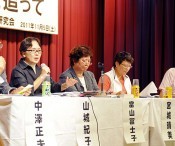
November 6, 2011 Ryukyu Shimpo
On November 5, at the Mawashi branch of JA-Okinawa in Naha, a public lecture entitled “Following mental trauma from the Battle of Okinawa” was held by the Society for Research on Mental Health in the Battle of Okinawa. Ryoji Aritsuka, a doctor of psychosomatic medicine at the Okinawa Kyodo Hospital, explained the realities of late-onset post-traumatic stress disorder (PTSD) triggered by an experience in the Battle of Okinawa. PTSD can manifest itself in the form of schizophrenia, depression and insomnia in several generations, even including a fetus. His research on PTSD related to the Battle of Okinawa indicates that the psychological damage suffered by people who experienced the Battle of Okinawa was hardly verified or treated during the post-war years when medical care largely lost its structure. Aritsuka pointed out that, “During the 66 years since the end of the war, some people and their families have suffered great pain and feelings of isolation.”
Aritsuka is the head of the Society for Research on Mental Health in the Battle of Okinawa. He introduced a case of PTSD from the Battle of Okinawa in which man in his 70s suffered insomnia probably caused by losing his mother on the battlefield when he was five years old, and a woman now in her 80s who has a burning sensation in her feet probably caused by having stepped on dead bodies to escape the battlefield when she was 14 years old. He explained that unlike these days, there was no mental care at that time, saying, “It was not treated in the period following the Battle of Okinawa. The unusual situation of Okinawa being occupied by a foreign country after the war also needs to be taken into consideration.”
He explained the features of PTSD in the Battle of Okinawa as being:
1. Great sorrow caused by a number of violent bereavements.
2. Experience of “utter depression” caused by losing a place to live.
3. Insomnia and panic disorder.
4. Insults and destructive behavior by the former Imperial Japanese Army.
5. Intergenerational transmission of poor parenting.
There are many cases in which people who witnessed the death of, or saw dead bodies of, family members during the battle went on to experience episodes of sleeplessness once they reached around 70 years old. Aritsuka explained that a death of a close relative also causes insomnia, and mentioned that research carried out overseas suggests that a war experience early in pregnancy may put the child at risk of schizophrenia.
Psychiatrist Masao Nakazawa, who deals with psychiatric research into bomb victims in Hiroshima, journalist Noriko Yamashiro, who is familiar with mental health issues in Okinawa, professor of Okinawa Prefectural College of Nursing, Fujiko Tomiyama, who has worked on the mental health of survivors as a health nurse, and Harumi Miyagi, a researcher of “group suicide” (shudan jiketsu) on Zamami Island, also contributed during the lecture.
(English translation by T&CT, Lima Tokumori and Mark Ealey)
Go To Japanese
November 7, 2011 Ryukyu Shimpo
Two American researchers, Mike Mochizuki and Michael O’Hanlon, have contributed an article to the website of CNN, America’s major cable news network, in which they advocate the relocation of the U.S. Marines in Okinawa to the United States.
This would suggest that a skeptical view of the current U.S. military realignment plan predominates in the United States.
Taking into account the current U.S. economic situation, United States military capabilities and the role of its forces, the political and social situation in Okinawa, the article puts forward a highly persuasive argument.
Japanese Prime Minister Yoshihiko Noda should read this article. We would like him to shake himself free from the cessation of thought initiated by the “U.S.-Japan Security Treaty Mafia” of bureaucrats of the Foreign Ministry and Defense Ministry and move back towards the kind of rational thinking reflected by this article.
Mike Mochizuki, professor at George Washington University and Michael O’Hanlon, senior fellow at Brookings, are both notable experts on the issues of U.S.-Japan relations and security.
They advocate that Washington should relocate about 8,000 of the Marines currently in Okinawa to California rather than to Guam, a stance similar to that which advocates that United States forces should be deployed to Japan either immediately before or during emergency situations.
Their article is based on two pillars of logic.
First, that the political climate in Okinawa needs to be taken into consideration. The article states, “Okinawan Governor Hirokazu Nakaima was re-elected in November 2010 on a platform opposing the current relocation plan; and he is almost certain to reject the upcoming application for a landfill, which is necessary to build the new airfield.”
Nakaima delivered a lecture on the Futenma relocation issue at George Washington University in Washington DC, this September. This may have helped convey his opposition to the current relocation plan to American experts on issues of U.S.-Japan relations and security.
The other point is that, “Second, and just as importantly in the era of American budgetary austerity, the Guam/Henoko plan is way too expensive.”
According to the U.S. Government Accountability Office, the current relocation plan could cost at least 29.1 billion dollars, meaning that each of the two countries would pay about 15 billion dollars.
In contrast to this, having navy and air force capabilities in forward-deployed locations would cost 5 billion dollars. The more rational of these options is clear to anyone who wishes to see.
The purpose of the current U.S. military realignment plan is the rational redeployment of United States military forces based on the concept of Revolution in Military Affairs. Highly advanced military technology no longer requires the deployment of military forces in particular locations. The Stryker Brigade Combat Team, a mechanized infantry force, that is an organic combined arms unit of light armored vehicles that could be deployed to locations all over the world within 96 hours, is symbolic of this trend. Transport vessels also exist that are capable of rapidly deploying United States forces.
Something else that should also be taken into account is that air forces now hold the key to success on the battlefield, with highly advanced military technologies making it possible for unmanned aerial vehicles to launch attacks.
With those factors in mind, by rights, the fact that the deployment of U.S. military forces overseas could be minimized should be the start point for their realignment.
The article co-written by Mike Mochizuki and Michael O’Hanlon reminds us of this.
On one side, the United States faces economic difficulties with huge military spending, and on the other side Japan faces fiscal pressure because of the need to spend on reconstruction projects in the wake of the Great East Japan Earthquake. Given that Japan and the United States would prefer to avoid huge financial expenditure, both governments should swiftly open their eyes to the logical conclusion regarding the Futenma issue.
(English Translation by T&CT, Mark Ealey)
Go To Japanese

November 6, 2011 Ryukyu Shimpo
“Rethink U.S. military base plans for Japan,” an article co-written by Mike Mochizuki, professor at George Washington University specializing in U.S.-Japan relations and Michael O’Hanlon, senior fellow at Brookings specializing in U.S. security and defense policy, was published on the website of Cable News Network (CNN) on November 4.
Mochizuki and O’Hanlon cast doubts on the possibility of relocation of Futenma Air Base to Henoko in Nago, referring to strident opposition to the current relocation plan from Nago Mayor Susumu Inamine and Okinawan Governor Hirokazu Nakaima.
Mochizuki and O’Hanlon propose that Washington should relocate about 8000 of the Marines currently in Okinawa to California instead of Guam. They claim that, “American capabilities in East Asia – the crucial matter – can then be sustained (if not actually enhanced) if Japan and the United States purchase extra equipment for those Marines and place it on maritime prepositioning vessels in Japanese waters where it can be quickly put to sea in the event of conflict and sailed to where forces are needed.”
Amid a growing number of voices in the U.S. Congress calling for the scaling down of U.S. military bases overseas, this article advocating the relocation of the U.S. Marines on Okinawa to the United States could influence the Futenma issue in the future.
With regard to the current relocation plan, Mochizuki and O’Hanlon said, “There are however two major problems with the existing plan.” They refer to the fact that in January 2010 voters in Nago elected a mayor who is clearly against the current relocation plan, and that Hirokazu Nakaima was re-elected as the governor in November 2010 on the basis of his opposing the current relocation plan. Mochizuki and O’Hanlon doubt that the current relocation plan is feasible, saying, “Okinawan Governor Hirokazu Nakaima was re-elected in November 2010 on a platform opposing the current relocation plan; and he is almost certain to reject the upcoming application for a landfill, which is necessary to build the new airfield.” “If the Japanese government were to force the construction of proposed Henoko facility, this is likely to provoke a physical clash with anti-base activists and erode the willingness of Okinawans to host more important U.S. bases on Okinawa, such as Kadena Air Force Base.”
They go on to state, “Second, and just as importantly in the era of American budgetary austerity, the Guam/Henoko plan is way too expensive. Lots of costly construction would be needed to make it happen – about $15 billion for each of the two countries.” “If Tokyo and Washington shared in the costs, equipment for the relocating Marines and ships to hold it in Japanese ports until needed could be purchased for around $5 billion, far less than the costs of the new construction projects.”
They wrote, “But a better approach would be to bring those Marines home to California where the inevitable downsizing of the broader U.S. Marine Corps will create space for them at existing bases.” “Keeping U.S. forces at existing bases in Japan is in fact a bargain, since Japan pays most of their local costs and since having Navy and Air Force capabilities in particular in forward-deployed locations is a big net positive for the United States. They can operate in the region from existing facilities on Okinawa and Japan’s main islands, with aircraft within combat radius of North Korea and the Taiwan Straits and ships within a couple days’ sail of each place.”
Mochizuki and O’Hanlon claim that attack submarines and unmanned aerial vehicles could be based on Guam due to highly advanced military technologies, and continued, “The incorrect perception that the United States was weakening its commitment to the Western Pacific with such a move could be countered in several ways.”
The fact that an influential media organization such as CNN has published this article reflecting the viewpoint of Mochizuki and O’Hanlon that casts doubts on the feasibility of the current relocation plan may have an impact on American public opinion.
Mochizuki hosted “Okinawa Question,” an international symposium, in which experts on U.S.-Japan security discussed the issue of the U.S. military bases in Okinawa and U.S.-Japan security policy.
(English Translation by T&CT, Mark Ealey)
Go To Japanese
Rethink U.S. military base plans for Japan(CNN)

November 5, 2011 Yukinao Chinen of Ryukyu Shimpo
On November 4, the members of the “Wings for Friendship between Fuzhou and Naha” delegation led by Naha Mayor Takeshi Onaga arrived in Fuzhou to commemorate the 30th anniversary of the signing of a friendly-relationship between the two cities. That evening a total of about 350 people from both sides attended the ceremony and the welcome party held by the Fuzhou Municipal Government to commemorate the milestone of the 30th anniversary of the relationship.
When addressing the delegation members from Okinawa, Yang Yue, the secretary of the Fuzhou Municipal Party Committee of the Fujian Committee of the Chinese Communist Party and a senior official in the Fuzhou Municipal Office, said, “Now that our exchange over the last 30 years is beginning to bear fruit in the various fields, the time has come to deepen the level of further exchanges between Fuzhou and Naha.”
Naha Mayor Onaga stated, “I visited here both ten and five years ago in my capacity as mayor, and I am very pleased to see the extent of development in Fuzhou. This is also a source of pleasure for the people of Naha. We hope that our strong bonds will be mutually beneficial and will help to bring about further prosperity and development.”
(English Translation by T&CT, Mark Ealey)
Go To Japanese

November 4, 2011 Ryukyu Shimpo
On October 23, at the Koza Sports Park in Okinawa City, “The First Koza A-lunch Competition” (hosted by Okinawa City Restaurant Business Association) was held to select the most popular “A-lunch,” a typical lunch menu in Okinawan restaurants. Eight restaurants located in and around Okinawa City put their best meal forward at a price of 500 yen, and a total of approximately 2,500 meals were served with many people lining up to try the meals.
This competition was held with the aim of revitalizing the city through “A-lunches,” a concept thought up by a chef at the New York Restaurant in Moromizato, Okinawa City after the Battle of Okinawa, and from there it spread throughout Okinawa. The association has actively promoted the A-lunch, creating an “A-lunch song” and selling special A-lunches at a Ryukyu FC soccer match held at the City’s Athletic Stadium.
At the Competition, people could vote once per meal ticket purchased. Families and friends of competitors enjoyed the A-lunches from each restaurant. At noon, long lines of hungry customers formed in front of each restaurant and competitors worked hard cooking and arranging foods inside the cooking booths. Tacos, deep-fried shrimps, hamburger steak, fried eggs, potatoes, sausages, spaghetti, salad, and many other items were available on the menu. Customers happily waited in a line to buy meals for the discounted prices.
Voting saw the Drive-in Restaurant Hawaii (Sakimotobu, Motobu City) win the highest award, the “A-Grand Prix,” the Mexican and Steak House Lima Restaurant (Moromizato, Okinawa City) came second in the “B-Grand Prix,” and Olive Batake (Awase, Okinawa City) came third, winning the “C-Grand Prix.”
(English Translation by T&CT, Megumi Chibana and Mark Ealey)
Go To Japanese
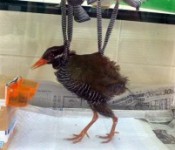
November 3, 2011 Ryukyu Shimpo
On November 2, the Ministry of the Environment’s Naha Nature Conservation Office announced numbers confirmed at the end of November 1 for accidents on roads involving Yanbarukuina or Okinawa rails and Ryukyu long-haired rats. The figures released represent a record-high for the prefecture.
There were 34 accidents involving Okinawa rails, an increase of one over the last year, when the highest number was recorded since 1995. However, the number involving Ryukyu long-haired rats was 22, an increase of five over the last year, making it the highest number recorded since 2005.
All of these accidents occurred within the Kunigami-son region.
According to the Yambaru Wildlife Conservation Center of the Ministry of the Environment, locals have seen many Okinawa rails out on the local roads. Center staff speculate that Okinawa rails may wander onto roads in search of food such as earthworms that they find in roadside gullies.
The increase in the number of accidents involving Ryukyu long-haired rats is in direct proportion to the increase in their population. The greatest proportion of the incidents occurred in the period after 7:00am.
The Office stated, “Drivers need to drive within the speed limits and to take extra care when driving in the northern area of Okinawa’s main island.”
The Office requests that people who hit these animals while out driving, or see injured animals, report this to the office.
For further details, call the Yambaru Wildlife Conservation Center of the Ministry of the Environment on 0980 (50) 1025.
(English Translation by T&CT, Mark Ealey)
Go To Japanese
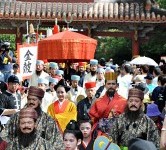
November 4, 2011 Ryukyu Shimpo
On November 3, at Shurijo Castle Park and on a nearby road in Naha, the 46th Ryukyu Kingdom Festival was held by Shuri Promotion Association. Many people turned out to see this year’s Koshiki Gyoretsu (Traditional Procession).
The Koshiki Gyoretsu revived the parade for the King of the Ryukyu Dynasty visiting three temples in the New Year, to pray a good harvest and the peace and security of the Ryukyu Kingdom. Commencing with the king and queen, followed by the sanshikan (the council of three ministers) and jokan (ladies of the court), who were the Kingdom officials in charge of national policy, a total of 300 people started from the Shurei-mon (gate), passed through the Ryutan Street and headed towards the Torihori intersection.
Twenty-nine year-old Naha resident Yuko Sugino, who goes to see the Koshiki Gyoretsu every year, said with a smile, “The costumes were very beautiful. I somehow felt that I had gone back in time, and that was a lot fun.”
(English Translation by T&CT, Lima Tokumori and Mark Ealey)
Go To Japanese

Go To Video1
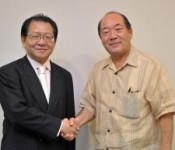
November 3, 2011 Ryukyu Shimpo
Orion Breweries Ltd., (Urasoe City, President Yoshio Kadekaru) had sold 6250 cases (52.2 kiloliters) of 350ml canned Orion draft beer in Hong Kong as of September 2011. These figures are more than twice the year’s sales target of 3000 cases and were achieved within just six months. Orion Beer is sold in 232 shops in mass merchandiser markets and plans are afoot for it to be sold in another 50 places in Hong Kong. Annual sales are now forecast to exceed 9000 cases.
Hong Kong import wholesale company Hoi Cheong Lung Ltd., (President Tony Yu) has been working with Orion Breweries from 2005. The success of its promotions has seen sales occurring through 150 shops from March and has resulted in a surge in sales. At the end of September, the sales performance had reached 59 kiloliters including bottled beer sales beyond those through Hoi Cheong Lung Ltd.
On November 2, Tony Yu visited the Ryukyu Shimpo office with Orion president Yoshio Kadekaru. Yu commented, “Compared to European beer, Orion’s taste is fresh, but not too strong and it is gaining popularity among young people in Hong Kong. Its price is a little on the high side, but it is superior in quality. We are keen to continue selling this good quality product in Hong Kong.”
(English Translation by T&TC, Shinako Oyakawa and Mark Ealey)
Go To Japanese
November 5, 2011 Ryukyu Shimpo
On November 4 at 7:36pm, a bat came in contact with an electric wire in Nishihara, Uruma City, causing a temporary outage for up to 2700 households centered on the Gushikawa area of Uruma City. According to the Okinawa Electric Power Company (OEPC), the supply of electricity was fully restored by 9:34pm.
OEPC reports that because the bat made contact with the electric wire of a power pole at Nishihara in Uruma City and received a shock, a grounding fault occurred in which the current flowed from the body of bat through the clasps of the power pole into the ground. According to the Uruma Police Station, they received a flurry of phone calls requesting information immediately after the power failure.
(English Translation by T&CT, Lima Tokumori and Mark Ealey)
Go To Japanese










 Webcam(Kokusai Street)
Webcam(Kokusai Street)


